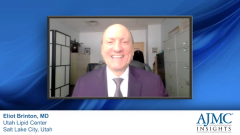
Unmet Needs in Lipid Management
Dr Eliot Brinton elaborates on unmet needs in lipid management and how they can be remedied.
Episodes in this series

Eliot Brinton, MD: The biggest unmet need that we have in lipid management is bringing patients’ LDL [low-density lipoproteins] cholesterol to goal. That sounds so simple, and we’ve been working on this for many decades, but well, over half in the neighborhood of 70% to 80% of the patients in this country who have had a prior cardiovascular event and who are sitting in our coronary care units today, have an LDL that is above their goal, and that’s a serious problem. In some ways, it’s simple and in other ways, it’s very complicated to get the LDL to goal. Somebody with a prior cardiovascular event, their LDL should be less than 70. If they haven’t had one, we maybe can use a slightly higher goal. Although very high-risk patients probably need that. Then many of our guidelines now are advocating an even lower LDL goal about less than 55 or even lower when the patient is at especially high risk. We have a need to get those patients down to goal. Of course, the problem is how to do it. It’s sometimes so easy to know what to do and so hard to do it in real life.
Then we come to the question of how do we do this in the real world? How can we get these patients down to goal? We do so poorly and yet we have lots of tools so what is happening and what’s not happening? Well in a word, we need to be more determined. Everyone involved in patient care must focus more intently on lowering LDL and the concept of an LDL goal or some people like to use the concept or the term threshold. That’s fine too but lowering LDL is the most important game in town when it comes to prevention of atherosclerotic cardiovascular disease [ASCVD] and we have many tools to do that. We must be determined but we need to have the patient cooperate. That’s where so much of the problem comes, is the patient isn’t doing what we have intended for them to do as a prescriber, provider, team member system. What we need to do is we need to listen to the patient, and we‘ve got to do a better job of building time into our system so that we can listen and that we do listen. Patients have their thoughts, they have their feelings, they have their dreams, they have their fears, they have their goals, their own objectives and we need to understand what they are. Almost everybody has searched statins on the web. Almost everybody has seen a preponderance of negative impressions about statins. The takeaway from the internet is that statins kill people and greedy pharma is trying to them by pushing expensive branded statins. Well, of course, none of that is true, but that‘s a perception that a lot of our patients have, and we don‘t know that unless we listen to them. Once we‘ve heard what they have to say, then we can and must push back and say, “Statins are inexpensive, they’re very safe. They’ve been very extensively tested. They’re very effective. They are our best treatment for prevention of heart attack and stroke.” If a patient does have a adverse effect on a statin and many patients do, then it’s very simple to stop the statin and let those adverse effects go away and then come back and restart a statin with either a lower dose or possibly a different statin or maybe less frequent dosing. We do quite a bit of once every other day or even once a week, once or twice a week dosing. That works very well. Statins don’t necessarily have a long life in the blood, but they have a very long half-life in terms of their effect on lipids. Once a week dosing is fine for pretty much any statin and of course, we can do it more frequently. Another important point here is that back in the day, we only had statins. That was it and we had to do what we called maximally tolerated statin therapy. It was statins or nothing. Then we started to get additional classes of agents that were proven to reduce cardiovascular events. First, came ezetimibe. Ezetimibe did not get a lot of attention primarily because it’s relatively weak for LDL lowering compared to a statin. It’s about 18% LDL lowering, and you think, well, that’s not much at all. I need to remind us about this so-called rule of 6. The rule of 6 is that when we double the dose of a statin, we only get another 6% LDL lowering. That’s great, 6% lowering is wonderful and it’s helpful, and it lowers events, but 6% per doubling means that if you go from, let’s say 5 mg of rosuvastatin to 40 mg, or let’s say you go from 10 mg of atorvastatin to 80 mg, you’re only getting another 18% LDL lowering. That’s exactly what ezetimibe does. When ezetimibe was first approved, we had a little kind of new math thing that was 10 + 10 = 80. That was if you have somebody on atorvastatin 10 mg plus ezetimibe 10 mg, it was the same LDL lowering as if you had somebody on atorvastatin 80 mg. That’s counterintuitive but for that reason, very important for us to remember that statin dosing is a strange thing and not necessarily what we would’ve thought off the top of our heads. We have these adjuncts. Ezetimibe is generic, it’s inexpensive, it’s very useful, it’s very effective. It’s generally very well tolerated, especially in patients who may have statin intolerance so you can go to a lower dose, less frequent dose, or if needed no dose of statin at all and then you have ezetimibe to fill in the gap. There’s another class of drug that was just approved a little over a year ago. Bempedoic acid is the drug in that class. Bempedoic acid is another statin adjunct. Now it happens to work near the same point where statins work so it’s, in some ways, a little bit less effective added to a statin than Ezetimibe but many of our patients are on very low dose or no statin at all. Despite our best efforts, despite our efforts to do what we call shared decision making, where we as the provider or the prescriber are saying something, and the patient says something back and hopefully we can come to the middle ground where we agree on what is the best thing to do. Let me just say, if the patient buys it, if they buy into the treatment, then they’re going to stick to it. If they don’t like the treatment, I can tell them what I want to tell them, and they’re going to go off and not do what I just said so we need shared decision making. It turns out then that with bempedoic acid, we have a huge advantage if the patient is not on a statin. Now of course, remember we’re always going to optimize and maximize statin therapy, but there are patients who can’t or won’t take a statin and bempedoic acid works a little harder in that case. There’s a fixed-dose combination of bempedoic acid plus ezetimibe making it even easier to treat that statin and tolerant or shall we say maybe statin-phobic patient who can’t or won’t take a statin. That’s a great adjunct and one that we don’t use very often at all. We’ve had now for several years the PCSK9 inhibitors and that is a wonderful class. They do excellently well. They’re better than statins for LDL lowering ,which is saying something. We have a couple of monoclonal antibodies and then just a couple of months ago, we had an approval of an siRNA agent for PCSK9, and these agents are wonderful. The siRNA isn’t quite as good as monoclonal antibodies, but it’s a very good drug and has an advantage of being dosed less frequently. It’s also dosed a little differently in the sense that it’s more of a procedure than a drug, a technicality that can be important in terms of getting the drug into the hands of the patient. We have these 3 excellent agents in the PCSK9 realm and they work very well as statin adjuncts, if a statin alone, even top dose of a high-intensity statin is not enough we can add ezetimibe we can go to the PCSK9 inhibitors, and these are all additives. Of course, PCSK9 inhibitors are especially important in the statin-intolerant patient, where they are getting only a little bit of lowering from either of the other agents, and then we can go to PCSK9s. The antibodies are proven to reduce cardiovascular events. That’s a huge plus. We’ve got a lot of statin-adjunct tools. We are blessed today with so many tools for getting the LDL cholesterol level down. The 2 main classes, the 2 first classes are now generic, and that’s the statins and ezetimibe. Then we have the branded class of bempedoic acid, and then 2 separate classes of PCSK9 agents that are all branded. They are affordable. Payers are good about paying for these medications. Today there isn’t any logical reason or theoretical reason that we can’t get a patient’s LDL to goal. The problem is in the logistics. The problem is in the actual patient adherence, patient compliance, the patient acceptance buy-in to this process. Does the patient share with us our anxiety to get their LDL down to an appropriate level? Let’s make sure we start with that as a base and then we talk about the various agents that we have. If we do a good job of shared decision-making with our patient where there’s a 2-way dialogue, it’s not just us preaching to them and telling them what they need to do, but we are hearing what they think about each of these options, then invariably, we can come to an agreement of something that will work. We will find something that will have acceptable adverse effects, acceptable efficacy for the patient. We can go to the payer. The payer will hopefully, agree with us on this and we can have this in a way that the patient can afford this medication and most importantly, to be on these treatments long term. A lot of times patients will take one month of the statin, or they’ll try 3 shots of a PCSK9 drug and then they say, well, I’m done. Did it work? Is my heart attack risk over? No, these are lifelong treatments and that’s why shared decision-making is so critical because the patient must be the one to stay with these medications on a routine basis to let us know if there are any adverse effects. We can deal with those. Don’t just stop taking the medication and don’t come back. We’ve got to find out what they’re doing, but together as a team, the doctors, the nurses, the pharmacists, the patient, the system, we can do much better than we are. We can get more patients’ LDL levels down to an appropriate level. We can reap the benefits of all the data that we have about atherosclerotic cardiovascular disease event reduction. ASCVD reduction is a fact, and we can do it for our patients if we simply are a patient. If we listen, if we work together as a team, we can do this. The key takeaway is start in the coronary care unit. You’ve got the patient’s attention. They just stepped back from the brink of death. They’re listening. If we do the testing that we need to and the treatment that we need to, when we’re starting this before they go home, then they remember, oh, this was important enough that we couldn’t wait. It wasn’t a matter of coming back in 3 months or 6 months, or whenever I got back to my doctor, we had to start it right away because it was going to save my life. It was going to prevent heart attack, stroke, disability, etc.
This transcript has been edited for clarity.
Newsletter
Stay ahead of policy, cost, and value—subscribe to AJMC for expert insights at the intersection of clinical care and health economics.











